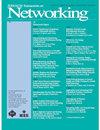异构并行服务器上的叉接调度分析
IF 3.6
3区 计算机科学
Q2 COMPUTER SCIENCE, HARDWARE & ARCHITECTURE
引用次数: 0
摘要
本文研究了一个由n个并行服务器组成的系统上的$(k,k)$ fork-join调度方案。到达系统的任务被分成k个子任务,并随机分配给k个服务器,其中每个任务可以独立分配给不同的慢速或快速服务器,选择概率分别为$p_{s}$或$1-p_{s}$。我们的分析表明,随着服务器数量n的增长,任意一组k队列上的固定工作负载的联合分布变得渐近独立,其中k缩放为$o\left ({{n^{\frac {1}{4}}}}\right)$。在渐近无关的情况下,极限平均任务完成时间可以表示为一个积分。然而,从分析的角度来看,计算最小化这个积分的最优选择概率$p_{s}^{\ast } $是一项挑战。为了解决这个问题,我们提供了限制平均任务完成时间的上界,并确定了最小化该上界的选择概率$\hat {p}_{s}$。我们通过数值实验验证了这种选择概率$\hat {p}_{s}$产生了接近最优的性能。本文章由计算机程序翻译,如有差异,请以英文原文为准。
Analysis of Fork-Join Scheduling on Heterogeneous Parallel Servers
This paper investigates the
$(k,k)$
fork-join scheduling scheme on a system of n parallel servers comprising both slow and fast servers. Tasks arriving in the system are divided into k sub-tasks and assigned to a random set of k servers, where each task can be assigned independently to a distinct slow or fast server with selection probability
$p_{s}$
or
$1-p_{s}$
, respectively. Our analysis demonstrates that the joint distribution of the stationary workload across any set of k queues becomes asymptotically independent as the number of servers n grows, with k scaling as
$o\left ({{n^{\frac {1}{4}}}}\right)$
. Under asymptotic independence, the limiting mean task completion time can be expressed as an integral. However, it is analytically challenging to compute the optimal selection probability
$p_{s}^{\ast } $
that minimizes this integral. To address this, we provide an upper bound on the limiting mean task completion time and identify the selection probability
$\hat {p}_{s}$
that minimizes this bound. We validate that this selection probability
$\hat {p}_{s}$
yields a near-optimal performance through numerical experiments.
求助全文
通过发布文献求助,成功后即可免费获取论文全文。
去求助
来源期刊

IEEE/ACM Transactions on Networking
工程技术-电信学
CiteScore
8.20
自引率
5.40%
发文量
246
审稿时长
4-8 weeks
期刊介绍:
The IEEE/ACM Transactions on Networking’s high-level objective is to publish high-quality, original research results derived from theoretical or experimental exploration of the area of communication/computer networking, covering all sorts of information transport networks over all sorts of physical layer technologies, both wireline (all kinds of guided media: e.g., copper, optical) and wireless (e.g., radio-frequency, acoustic (e.g., underwater), infra-red), or hybrids of these. The journal welcomes applied contributions reporting on novel experiences and experiments with actual systems.
 求助内容:
求助内容: 应助结果提醒方式:
应助结果提醒方式:


